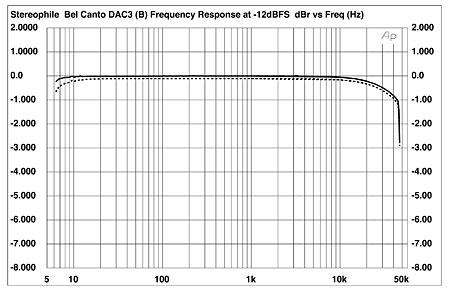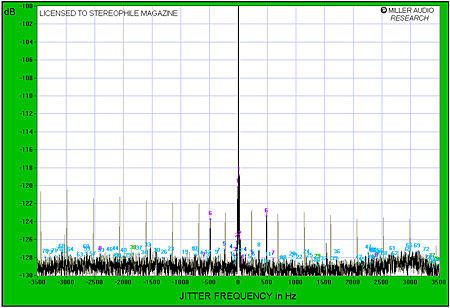| Columns Retired Columns & Blogs |
Bel Canto e.One DAC3 D/A processor Measurements
Sidebar 3: Measurements
The Bel Canto e.One DAC3's S/PDIF and AES/EBU inputs successfully locked on to datastreams with sample rates varying from 32kHz to 96kHz. Feeding my Macintosh laptop to the DAC3's USB input resulted in the Bel Canto appearing in the computer's Sounds menu as "USB Audio Codec." The DAC3 is specified as being able to handle sample rates up to only 48kHz via its USB input. It did so without problem, though there were very slight changes in output level apparent when I fed it a continuous tone via USB. (This didn't happen with the other inputs.)
The DAC3's maximum output level was close to specification, at 4.45V balanced, 2.21V unbalanced, sourced from low impedances of 200 and 496 ohms, respectively. These figures didn't change with frequency. Unusually, both inputs inverted signal polarity, suggesting that the XLRs are wired with pin 3 rather than pin 2 hot.
Unless noted otherwise, the measurements were performed feeding the Bel Canto DAC3 with WAV data sourced via a TosLink connection from a PC fitted with an RME soundcard and looking at the processor's balanced analog outputs with the volume control bypassed. The DAC3's frequency response with CD data was flat within the audioband, with a 0.2dB drop at 20kHz (fig.1). With 96kHz-sampled data, the response continued to roll off gently at ultrasonic frequencies before beginning the usual plummet at 45kHz. As can be seen from this graph, the channels are very closely matched in level; this excellent matching was not changed by the volume-control setting. Channel separation (not shown) was superb, at 130dB in both directions over much of the audioband from the balanced outputs, and only 6dB worse from the unbalanced.

Fig.1 Bel Canto e.One DAC3, frequency response into 100k ohms, 96kHz-sampled DVD-A data at –12dBFS (right channel dashed, 0.5dB/vertical div.).
The DAC3 demonstrated superb resolution. The top pair of traces in fig.2 shows the spectrum of the processor's output while reproducing dithered 16-bit data representing a 1kHz tone at –90dBFS, produced by sweeping a 1/3-octave bandpass filter down from a center frequency of 20kHz to one of 20Hz. No spuriae are visible, and in fact, all that the traces show is the spectral content of the recorded dither noise. Increasing the word length to 24 bits gave the middle pair of traces in fig.2. The noise floor has dropped by an extraordinary 25dB, suggesting that the DAC3's intrinsic resolution is better than 20 bits, and there is a complete absence of harmonic or power-supply spuriae. This is pretty much the state of the art; the only products I have measured in the past few years that have come close to matching this performance were the Logitech (originally Slim Devices) Transporter reviewed by Wes Phillips last February, and the Weiss Medea reviewed by Kal Rubinson in February 2003. Dropping the signal level to –120dBFS still gave a spectral peak 20dB above the background noise (fig.2, bottom traces). As I said, extraordinary!

Fig.2 Bel Canto e.One DAC3, 1/3-octave spectrum with noise and spuriae of (from top to bottom at 3kHz): dithered 1kHz tone at –90dBFS with 16-bit CD data and 24-bit DVD-A data; dithered 1kHz tone at –120dBFS with 24-bit DVD-A data (right channel dashed).
Extending the measurement bandwidth to 200kHz and feeding the Bel Canto 16-bit data representing a –1LSB DC offset gave a spectrum with a noise floor below –140dBFS and only a slight rise in noise above 80kHz (not shown). Plotting the linearity error with dithered 16-bit data (fig.3) gave a trace that is dominated by the dither noise, while the DAC3's superb resolution and low level of analog noise meant that its reproduction of an undithered 16-bit tone at exactly –90.31dBFS was essentially perfect (fig.4). Not only are the three DC voltage levels described by the data well resolved, with excellent waveform symmetry, but the Gibbs Phenomenon "ringing" at each transition is clearly visible. Increasing the word length to 24 bits gave an excellent facsimile of a sinewave, even at this "roots of the universe" signal level (fig.5).

Fig.3 Bel Canto e.One DAC3, left-channel departure from linearity, 16-bit data (2dB/vertical div.).

Fig.4 Bel Canto e.One DAC3, waveform of undithered 1kHz sinewave at –90.31dBFS, 16-bit data.

Fig.5 Bel Canto e.One DAC3, waveform of undithered 1kHz sinewave at –90.31dBFS, 24-bit data.
The DAC3 offered very low levels of harmonic distortion. Fig.6 shows an FFT-derived spectrum of its unbalanced output while it reproduced a full-scale, 24-bit 1kHz tone into a fairly low impedance (8k ohms). The highest-level harmonic is the second, at just –100dB (0.001%), with the third and fourth harmonics close to –110dB. The noise floor in this graph is actually that of the analyzer, which has less dynamic range than the Bel Canto. Dropping the 24-bit signal level to –90dB brought the Bel Canto's noise up above that of the analyzer (fig.7), and now the fifth harmonic can be seen. That this noise floor is higher than that shown in fig.2 with the same signal is due both to this measurement being made from the unbalanced output and the DAC3's volume control being set to "94" (–6dB). Intermodulation distortion was also superbly low in level (fig.8), with the difference component lying at –112dB left (black trace) and –106dB right (red).

Fig.6 Bel Canto e.One DAC3, spectrum of 1kHz sinewave at 0dBFS into 8k ohms (linear frequency scale).

Fig.7 Bel Canto e.One DAC3, unbalanced spectrum of 1kHz sinewave at –90dBFS into 8k ohms (linear frequency scale).

Fig.8 Bel Canto e.One DAC3, unbalanced HF intermodulation spectrum, 19+20kHz at 0dBFS peak into 8k ohms (linear frequency scale).
Assessed with the Miller Jitter Analyzer, the DAC3 featured superb rejection of word-clock jitter, even when fed via the inherently jittery TosLink connection. With 16-bit data sourced from the PC-RME combination, the jitter level was just 147 picoseconds peak–peak, with the data-related sidebands close to the residual level in the test signal (a high-level tone at exactly one quarter the sample rate overlaid with a squarewave produced by toggling the LSB at 1/192 the same rate). These sidebands are shown as the grayed-out trace in fig.9. The black trace in this graph was produced by driving the DAC3 with 24-bit data representing the same signal. The only sidebands visible, all of unknown origin, lie at ±15.6Hz (purple "1" markers), ±31.2Hz (purple "2"), and ±490Hz (purple "6"), with the total jitter just 94.1ps p–p.

Fig.9 Bel Canto e.One DAC3, high-resolution jitter spectrum of analog output signal (11.025kHz at –6dBFS, sampled at 44.1kHz with LSB toggled at 229Hz), 24-bit data sourced from PC via 1m TosLink (16-bit data, grayed out). Center frequency of trace, 11.025kHz; frequency range, ±3.5kHz.
Repeating these tests feeding the Bel Canto's USB input, I wasn't sure what to expect, as the bit and word clocks are no longer embedded in the data; in fact, the data clock is generated locally. While the jitter with 24-bit data was even lower than with TosLink data, at just 63.2ps (fig.10, black trace), 16-bit data gave a moderately high 637.3ps, dominated by data-related sidebands (fig.10, grayed-out trace). Does this measured performance correctly characterize the DAC3's performance via its USB input? Was, for example, the very low 24-bit figure due to the data being truncated to 16 bits? Test-equipment manufacturer Audio Precision recently loaned me a sample of their state-of-the-art 2722 analyzer; in subsequent issues I will be further investigating this aspect of the Bel Canto's behavior, along with some other new digital processors.

Fig.10 Bel Canto e.One DAC3, high-resolution jitter spectrum of analog output signal (11.025kHz at –6dBFS, 24-bit data sampled at 44.1kHz with LSB toggled at 229Hz), 16-bit CD data sourced from battery-powered Mac TiBook via USB 1.1 connection. Center frequency of trace, 11.025kHz; frequency range, ±3.5kHz.
Other than the jitter performance via its USB input, the Bel Canto e.One DAC3 is the best-measuring digital component I have encountered. It offers some impressive audio engineering in both the digital and analog domains.—John Atkinson
- Log in or register to post comments




































